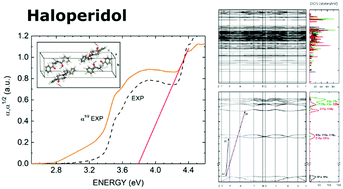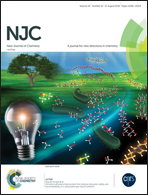First-generation antipsychotic haloperidol: optical absorption measurement and structural, electronic, and optical properties of its anhydrous monoclinic crystal by first-principle approaches†
Abstract
The fifty years old first-generation antipsychotic drug haloperidol is very effective in the therapy of the positive symptoms of schizophrenia and mania, but its solid-state properties remain veiled. To fill this gap, the anhydrous monoclinic crystal of haloperidol, was investigated through calculations employing density functional theory (DFT) within the generalized gradient approximation (GGA) and including the dispersion effects (TS). The optical absorption measurements revealed that the anhydrous monoclinic haloperidol crystal is a wide band gap material with a 3.8 eV indirect main gap energy and an optical absorption onset due to a Frenkel exciton with a binding energy of 1.1 eV and charge-transfer excitons with a binding energy of 0.2–0.5 eV. The DFT-GGA+TS modeling produced structural parameters in very good agreement with the X-ray data, with the calculated band gap energy smaller than the experimental data by about 36%, with an indirect band gap corresponding to α1 → β1 transition. After applying the Δ-sol gap correction scheme, the main gap increased to 3.72 eV, almost matching the experimental gap estimation. Theoretical simulations within the time-dependent DFT formalism, on the other hand, predicted a Frenkel exciton with a binding energy of 1.6 eV, about 45% larger than the experimental estimation. It was found that electronic wavefunctions mainly originating from the 2p states of oxygen (O1) and nitrogen (N1) atoms contribute to the highest valence energy band, while the 2p states of C15, C16, C19, C21, and O2 atoms contribute most significantly to the lowest conduction energy bands. Analysis showed that the unit cell was less stiff along the b direction than the a and c directions. Finally, calculations pointed to a high degree of optical anisotropy for the absorption and complex dielectric function, with more structured curves for incident light polarized along the 100 and 001 directions.



 Please wait while we load your content...
Please wait while we load your content...